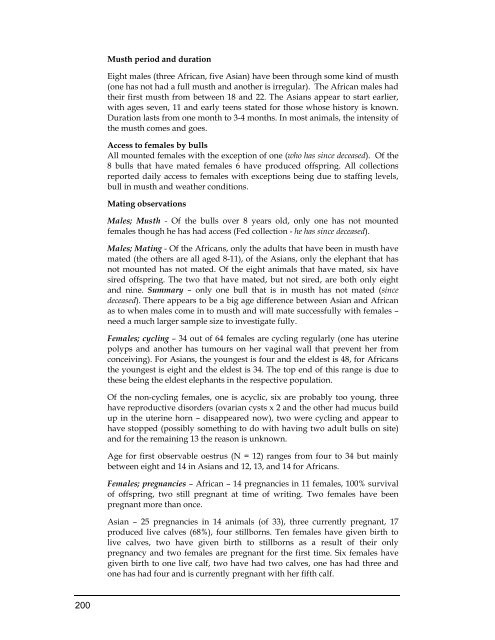Elephants Elephants - Wildpro - Twycross Zoo
Elephants Elephants - Wildpro - Twycross Zoo
Elephants Elephants - Wildpro - Twycross Zoo
Create successful ePaper yourself
Turn your PDF publications into a flip-book with our unique Google optimized e-Paper software.
200<br />
Musth period and duration<br />
Eight males (three African, five Asian) have been through some kind of musth<br />
(one has not had a full musth and another is irregular). The African males had<br />
their first musth from between 18 and 22. The Asians appear to start earlier,<br />
with ages seven, 11 and early teens stated for those whose history is known.<br />
Duration lasts from one month to 3-4 months. In most animals, the intensity of<br />
the musth comes and goes.<br />
Access to females by bulls<br />
All mounted females with the exception of one (who has since deceased). Of the<br />
8 bulls that have mated females 6 have produced offspring. All collections<br />
reported daily access to females with exceptions being due to staffing levels,<br />
bull in musth and weather conditions.<br />
Mating observations<br />
Males; Musth - Of the bulls over 8 years old, only one has not mounted<br />
females though he has had access (Fed collection - he has since deceased).<br />
Males; Mating - Of the Africans, only the adults that have been in musth have<br />
mated (the others are all aged 8-11), of the Asians, only the elephant that has<br />
not mounted has not mated. Of the eight animals that have mated, six have<br />
sired offspring. The two that have mated, but not sired, are both only eight<br />
and nine. Summary – only one bull that is in musth has not mated (since<br />
deceased). There appears to be a big age difference between Asian and African<br />
as to when males come in to musth and will mate successfully with females –<br />
need a much larger sample size to investigate fully.<br />
Females; cycling – 34 out of 64 females are cycling regularly (one has uterine<br />
polyps and another has tumours on her vaginal wall that prevent her from<br />
conceiving). For Asians, the youngest is four and the eldest is 48, for Africans<br />
the youngest is eight and the eldest is 34. The top end of this range is due to<br />
these being the eldest elephants in the respective population.<br />
Of the non-cycling females, one is acyclic, six are probably too young, three<br />
have reproductive disorders (ovarian cysts x 2 and the other had mucus build<br />
up in the uterine horn – disappeared now), two were cycling and appear to<br />
have stopped (possibly something to do with having two adult bulls on site)<br />
and for the remaining 13 the reason is unknown.<br />
Age for first observable oestrus (N = 12) ranges from four to 34 but mainly<br />
between eight and 14 in Asians and 12, 13, and 14 for Africans.<br />
Females; pregnancies – African – 14 pregnancies in 11 females, 100% survival<br />
of offspring, two still pregnant at time of writing. Two females have been<br />
pregnant more than once.<br />
Asian – 25 pregnancies in 14 animals (of 33), three currently pregnant, 17<br />
produced live calves (68%), four stillborns. Ten females have given birth to<br />
live calves, two have given birth to stillborns as a result of their only<br />
pregnancy and two females are pregnant for the first time. Six females have<br />
given birth to one live calf, two have had two calves, one has had three and<br />
one has had four and is currently pregnant with her fifth calf.

















